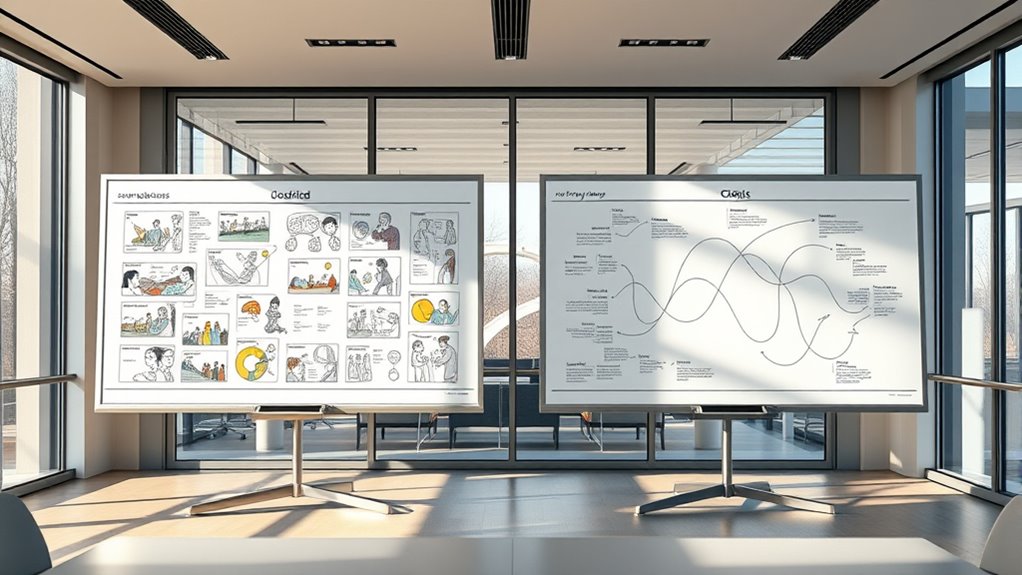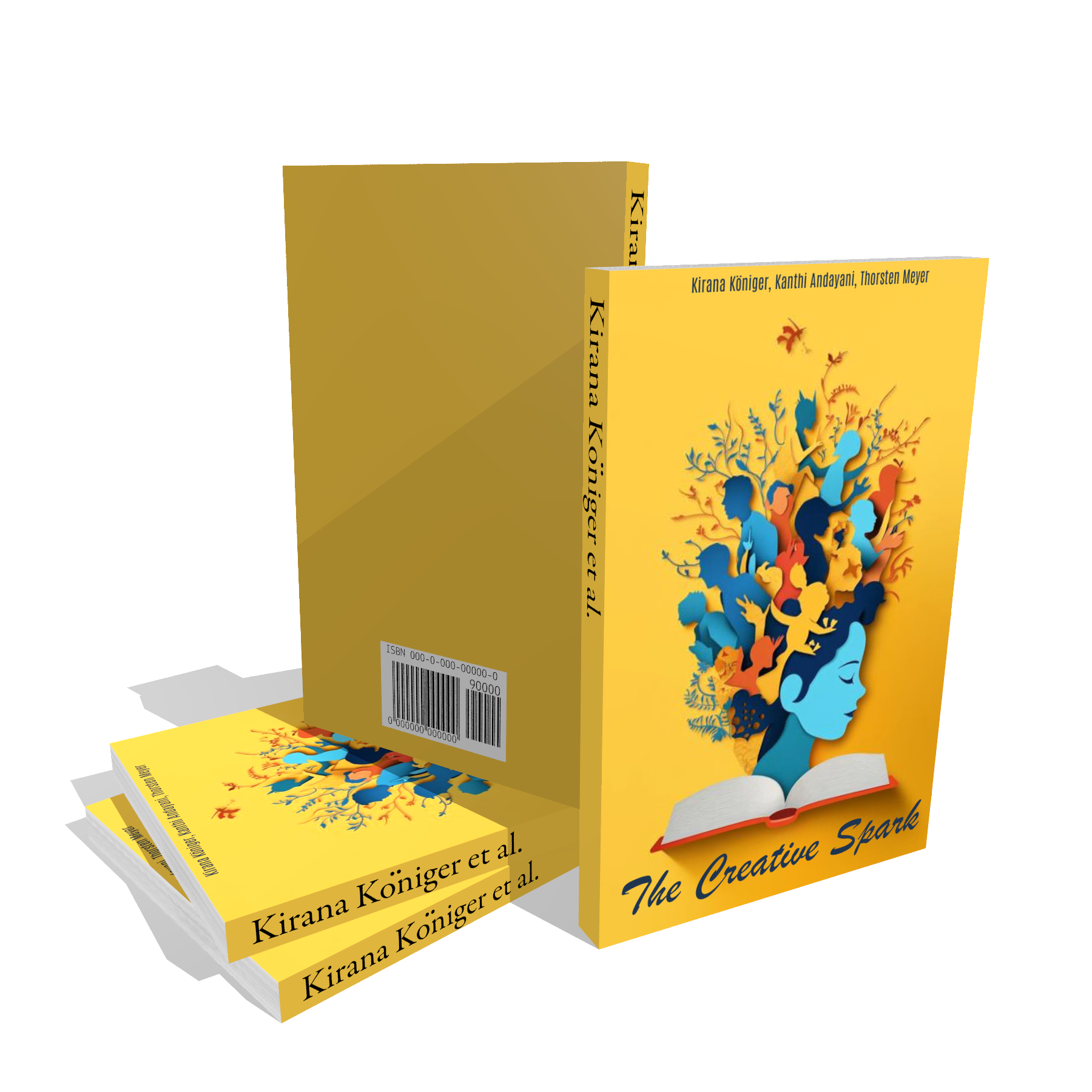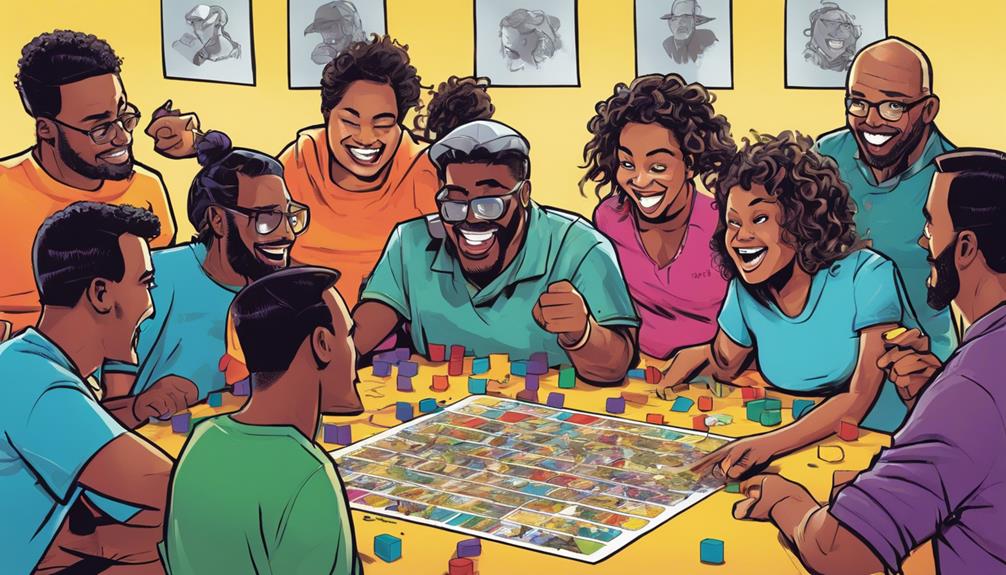Choosing between storyboards and journey maps for stakeholder pitches depends on your goals. If you want emotional engagement and quick understanding, storyboards excel by telling a compelling story visually. If you need a detailed view of user experiences and processes, journey maps provide clarity. Both are versatile and can be tailored to your audience. To master which tool best fits your pitch and how to combine them effectively, keep exploring the key differences and strategies.
Key Takeaways
- Use storyboards for emotional storytelling and quick engagement; choose journey maps for detailed process understanding.
- Storyboards excel in capturing stakeholder attention through vivid narratives; journey maps foster empathy with comprehensive user insights.
- Select storyboards for presenting high-level concepts; opt for journey maps when emphasizing complex workflows or touchpoints.
- Storyboards are more flexible for rapid, simplified communication; journey maps are better suited for in-depth analysis and stakeholder alignment.
- The winning tool depends on the pitch goal: emotional impact and clarity favor storyboards, while detailed understanding favors journey maps.
Defining the Core Purposes of Storyboards and Journey Maps
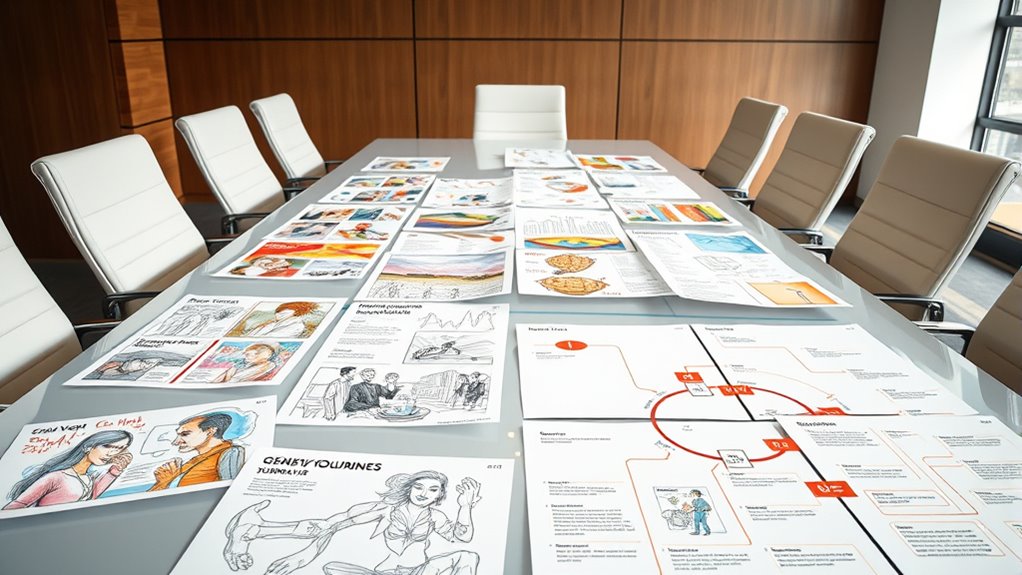
While both storyboards and journey maps serve as visual tools in the design process, they each have distinct core purposes. Storyboards primarily focus on illustrating a user’s experience through a narrative, helping you communicate how a user interacts with your product or service. They often incorporate user personas to bring these stories to life and facilitate stakeholder alignment by visualizing scenarios clearly. Journey maps, on the other hand, emphasize the entire user experience, highlighting pain points and moments of delight along the way. They help you understand user needs at each stage and ensure everyone involved shares a common understanding. Additionally, understanding the role of visual fidelity in creating effective storyboards and journey maps can significantly impact the clarity of communication. Together, these tools align your team’s vision and keep user-centered goals front and center throughout your project.
Visual Appeal and Emotional Impact in Stakeholder Engagement
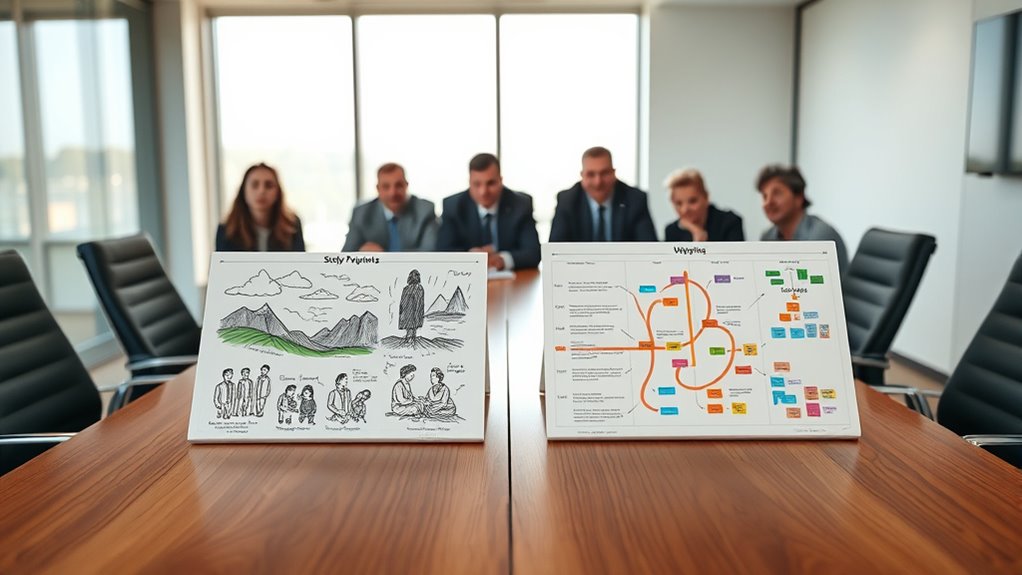
You want your visuals to capture attention and evoke emotion, making stakeholders feel connected to the story. Engaging visual narratives can turn complex ideas into memorable experiences that resonate deeply. When your visuals create emotional impact, stakeholder engagement becomes more authentic and compelling. Incorporating visual appeal into your presentations can significantly influence how your message is received and remembered.
Engaging Visual Narratives
Engaging visual narratives capture your audience’s attention by combining compelling imagery with clear storytelling, making complex ideas easier to understand. When you use creative storytelling through visuals, you guide stakeholders seamlessly through your message, keeping them invested. Visual communication enhances this by transforming abstract concepts into relatable, easily digestible visuals. Whether you’re presenting a storyboard or a journey map, the goal is to craft a story that resonates and sticks. Effective visual narratives not only clarify your message but also evoke curiosity and interest. By focusing on visual appeal and storytelling clarity, you ensure your audience remains engaged, understands your vision, and feels connected to your ideas—making your stakeholder pitch memorable and impactful. Incorporating visual storytelling strategies can significantly improve how your message is received and remembered.
Emotional Resonance Effect
Visual appeal plays a crucial role in creating emotional resonance with your audience, as striking images and well-designed layouts evoke immediate feelings and connections. When your visuals are compelling, they boost emotional engagement, making your message memorable and impactful. This emotional connection encourages stakeholders to care about your project, fostering trust and openness. By carefully choosing visuals that resonate with your audience’s values and aspirations, you strengthen the overall narrative. Whether through vivid imagery or thoughtful design, you tap into their emotions, making your presentation more persuasive. Ultimately, a visually appealing approach enhances audience connection, ensuring your ideas are not just heard but felt—turning passive viewers into active supporters. Incorporating cozy textiles and warm color palettes in your visuals can further deepen this emotional resonance by creating a sense of comfort and familiarity.
Clarity and Detail in Communicating Processes and Concepts
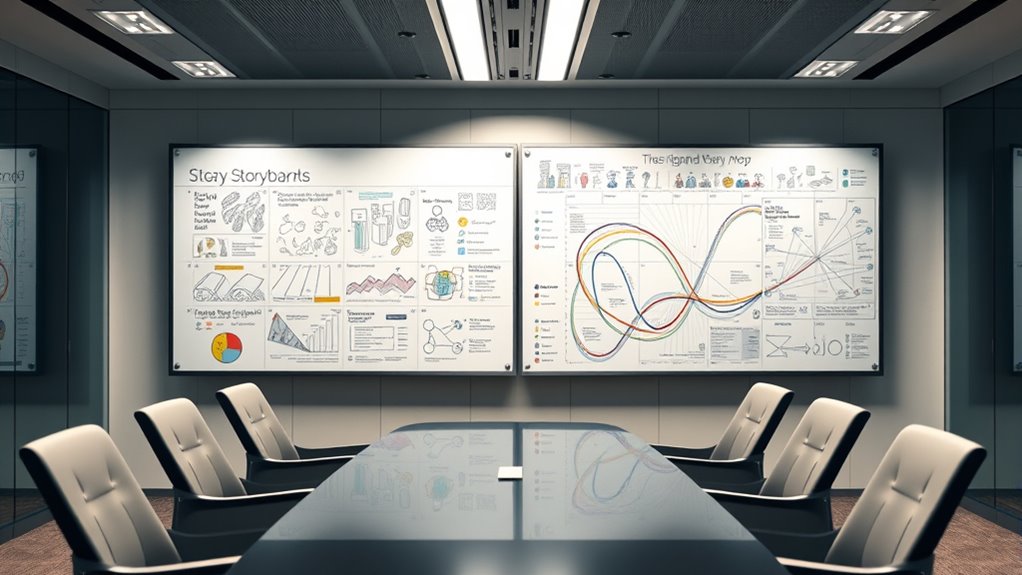
Effective communication depends on how clearly your visuals convey processes and ideas. You’ll want to contemplate which method offers better process clarity and how well it simplifies complex concepts. By comparing their storytelling strengths, you can choose the approach that makes your message straightforward and impactful. Incorporating visual organization techniques can further enhance understanding by presenting information in a more structured and digestible manner.
Visual Storytelling Effectiveness
While both storyboards and journey maps aim to communicate processes clearly, their ability to do so depends on how well they convey details and concepts visually. Storyboards excel at illustrating abstract concepts through sequential visuals, making complex ideas more tangible. They enable you to capture technical specifications by showing interactions and progressions step-by-step. Journey maps, on the other hand, are better at mapping user experiences, providing a holistic view of touchpoints and emotions. However, they can sometimes lack the detailed precision needed for technical specifications or abstract ideas. To maximize visual storytelling effectiveness, choose the format that best highlights the nuances of your content—storyboards for detailed processes and journey maps for overarching experiences. Clear visuals guarantee your message resonates with stakeholders. Additionally, understanding Halloween Product Reviews can help in creating engaging visuals that capture the audience’s interest effectively.
Level of Process Clarity
Choosing the right tool influences how clearly your process or concept is communicated. Both storyboards and journey maps aim to simplify complex ideas, but they differ in their approach to process clarity. A storyboard can break down steps visually, providing process simplification and highlighting key moments. This clarity helps stakeholders understand workflows quickly and reduces misunderstandings. Conversely, journey maps offer a broader overview, emphasizing user experience and emotional touchpoints, which can sometimes obscure detailed processes. Your choice impacts stakeholder alignment: if clarity and detailed process communication are priorities, storyboards often excel. They allow you to present processes step-by-step, making intricate concepts accessible. Ultimately, selecting the right tool ensures your message is clear, process details are understood, and stakeholder buy-in is strengthened.
Conveying Complex Ideas
When it comes to conveying complex ideas, the clarity and level of detail you provide can make or break understanding. Using creative storytelling helps you frame intricate concepts in relatable ways, making them easier to grasp. Pairing this with effective data visualization allows you to present data-driven insights visually, highlighting key relationships and patterns. Both storyboards and journey maps can incorporate these techniques, but storyboards excel at illustrating sequential processes through vivid scenes, engaging viewers emotionally. Journey maps, on the other hand, focus on touchpoints and experience flow, often benefiting from clear data visualization to show metrics or pain points. To communicate complex ideas effectively, choose the method that best combines storytelling with visual clarity, ensuring your audience fully comprehends the message.
Flexibility and Adaptability for Different Presentation Contexts
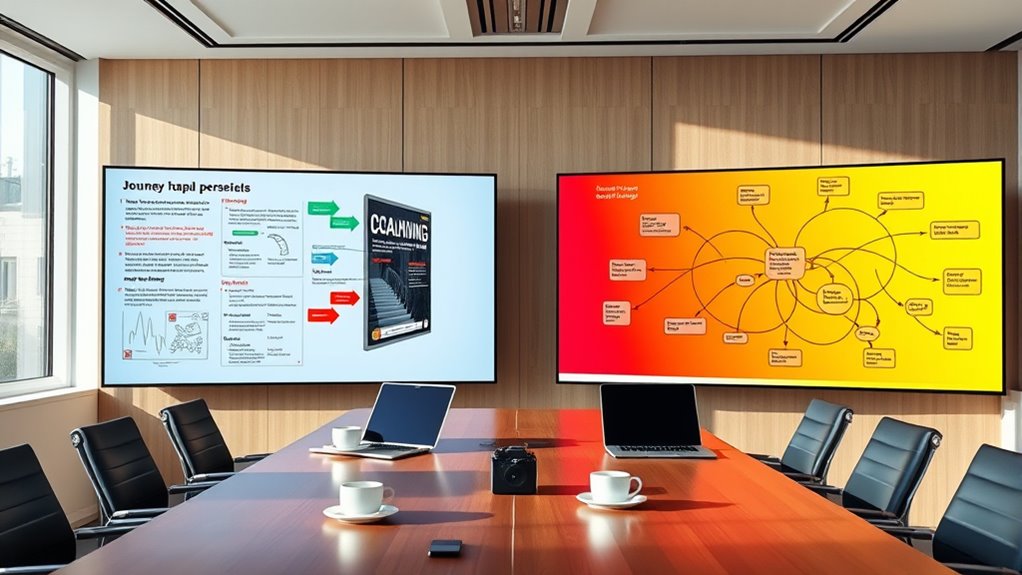
Both storyboards and journey maps need to be adaptable to fit various presentation contexts, whether you’re pitching to stakeholders, training team members, or presenting to clients. Their format flexibility allows you to tailor each tool to suit your audience’s needs. For example, storyboards can be simplified into quick sketches for quick pitches or detailed for in-depth discussions. Journey maps can be expanded or condensed depending on the level of detail required. This flexibility helps guarantee your message resonates, regardless of the setting. Additionally, both tools offer strong context adaptability, letting you emphasize different aspects—such as user emotions or technical steps—based on your goals. For instance, leveraging content discoverability can help highlight trending themes or key features relevant to your audience. Ultimately, being able to modify these visual tools makes your presentations more effective across diverse situations.
Strengths and Limitations of Each Tool in Persuasion
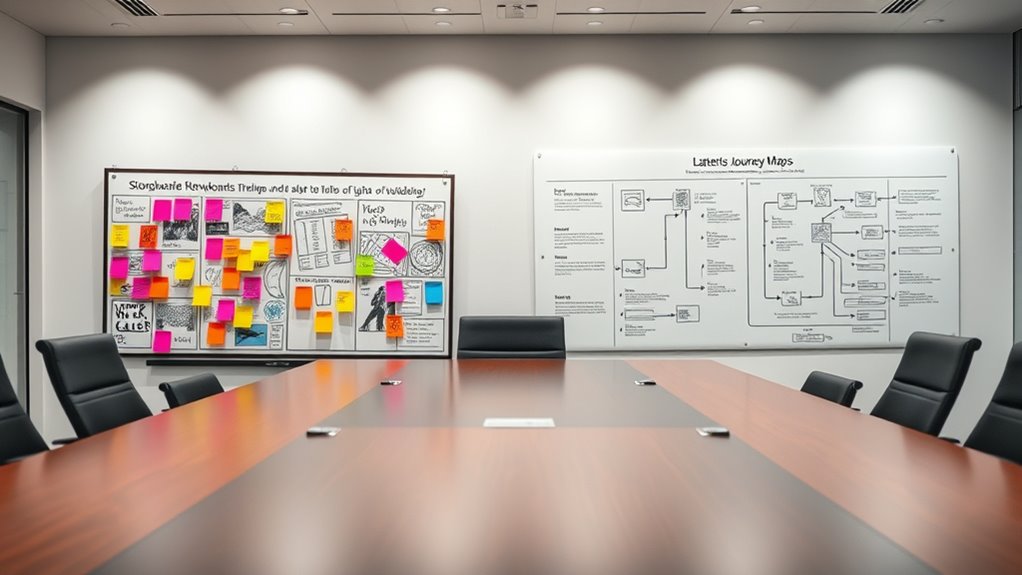
Storyboards and journey maps each have unique strengths that make them powerful tools for persuasion, but their effectiveness also depends on their limitations. Storyboards excel at engaging stakeholders through visual storytelling, making complex ideas relatable and emotionally compelling. They leverage persuasion techniques like narrative flow and emotional appeal to drive stakeholder engagement. However, their limitation lies in oversimplifying details, which can overlook critical technical or logistical considerations. Journey maps, on the other hand, provide a detailed, user-centered view of experiences, fostering understanding and empathy. They are effective for highlighting pain points and process improvements, but their complexity can overwhelm stakeholders or dilute key messages. Recognizing these strengths and limitations helps you select the best tool to persuade your audience effectively. Additionally, understanding how to align these tools with mindset and intentions can further enhance their persuasive power.
Choosing the Right Visual Approach for Your Audience
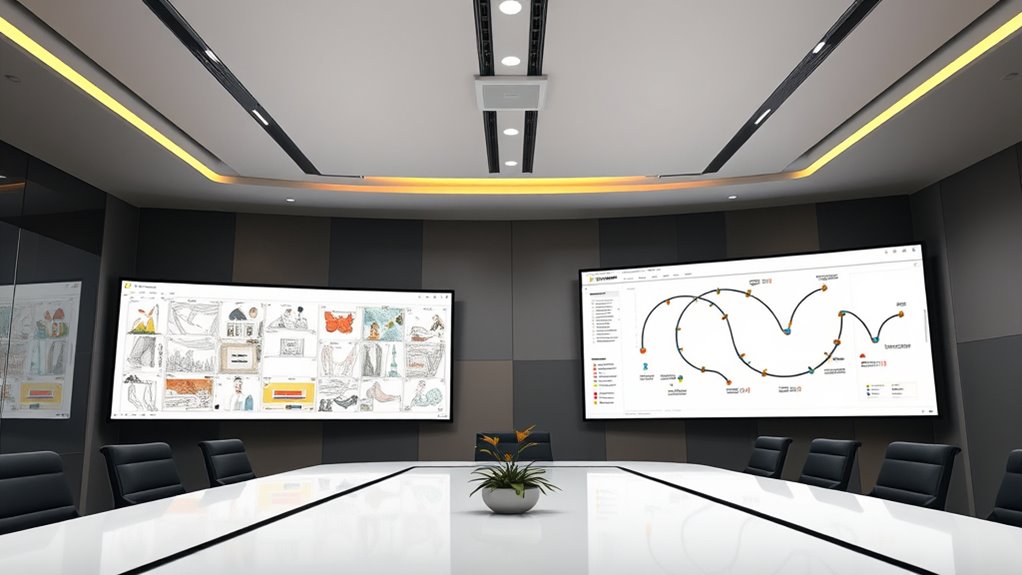
Choosing the right visual approach hinges on understanding your audience’s needs, preferences, and decision-making style. To do this effectively, focus on establishing a clear visual hierarchy that guides their attention to key points. Use color psychology to evoke the desired emotions and reinforce your message—warm colors for excitement or urgency, cool tones for trust and calmness. Consider whether your audience prefers storytelling through vivid visuals or prefers straightforward data presentation. Tailor your visuals to match their familiarity with the content, ensuring clarity and engagement. By aligning your visual strategy with their preferences, you’ll create more impactful pitches, whether using storyboards or journey maps, and increase your chances of successfully conveying your message. Additionally, selecting the appropriate visual tools can significantly influence how well your audience connects with the content.
Practical Tips for Integrating Storyboards and Journey Maps Effectively
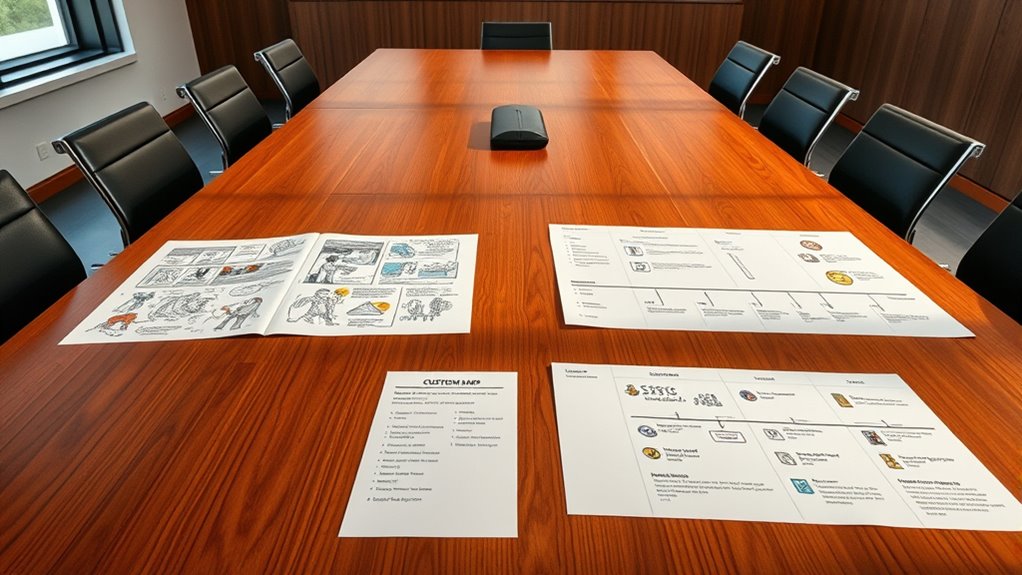
To effectively integrate storyboards and journey maps, start by clearly defining your project’s goals and the specific insights you want to communicate. Use creative storytelling to craft a compelling narrative that resonates with your audience, making complex ideas more relatable. Combine journey maps’ detailed touchpoints with storyboards’ visual flow to enhance audience engagement. Keep your visuals simple and focused, emphasizing key moments that drive your message home. Align both tools to highlight different perspectives, reinforcing your overall story. Regularly gather feedback from stakeholders to refine your approach, ensuring your integration remains clear and impactful. Incorporate an understanding of zodiac sign compatibility to tailor your storytelling approach to diverse audience preferences. By blending these techniques thoughtfully, you’ll create a cohesive presentation that captures attention and convinces your audience effectively.
Frequently Asked Questions
How Do Storyboards and Journey Maps Compare in Cost and Resource Requirements?
When comparing cost and resource needs, storyboards often require more time and creative effort, making them pricier and more resource-intensive. Journey maps typically involve gathering data and customer insights, which can be less costly but still demand significant resource allocation. You’ll find that storyboards need more extensive planning and visual creation, while journey maps focus on analysis, affecting your overall cost comparison and resource allocation strategies.
Can Storyboards or Journey Maps Be Effectively Used in Virtual or Remote Presentations?
Coincidentally, both storyboards and journey maps excel in virtual presentations, especially through digital collaboration platforms. You can use interactive features to boost audience engagement, making your visuals more dynamic and accessible. Whether you choose storyboards for storytelling or journey maps for process clarity, digital tools help you connect effectively with remote stakeholders. This approach guarantees your message resonates, regardless of physical distance, enhancing overall presentation impact.
Which Tool Is Better Suited for Complex, Multi-Stage Projects?
You should choose a journey map for complex, multi-stage projects because it offers better complexity handling and multi-stage clarity. It visually breaks down each step, helping stakeholders understand the entire process and identify potential issues early. Storyboards are more suited for visual storytelling and single moments, but for detailed project workflows, journey maps provide the structure and depth you need to communicate effectively across all project stages.
How Do Cultural Differences Influence the Effectiveness of Each Visual Tool?
Cultural nuances and communication styles greatly influence how visual tools like storyboards or journey maps are received. You should consider that some cultures prefer direct, concise visuals, while others value detailed storytelling. By adapting your approach to these cultural differences, you guarantee your message resonates more effectively. Recognizing these nuances helps you choose the right tool and presentation style, making your stakeholder pitch more compelling and culturally sensitive.
Are There Specific Industries or Sectors Where One Approach Consistently Outperforms the Other?
Think of industry-specific storytelling as a tailored suit—perfectly fitting your sector’s needs. In sectors like technology and healthcare, journey maps often outperform storyboards because they highlight processes and user experiences clearly. Conversely, creative industries such as advertising benefit from storyboards that bring ideas to life visually. Sector-focused visualization helps you communicate more effectively, ensuring your message resonates precisely with your audience’s expectations.
Conclusion
Ultimately, choosing between storyboards and journey maps depends on your audience and goals. Did you know that 85% of stakeholders find visual storytelling more memorable? By understanding each tool’s strengths, you can craft compelling pitches that resonate and persuade. Whether you opt for the emotional appeal of storyboards or the process clarity of journey maps, integrating both can boost your chances of winning stakeholder support. Trust your instincts and tailor your approach for maximum impact.
